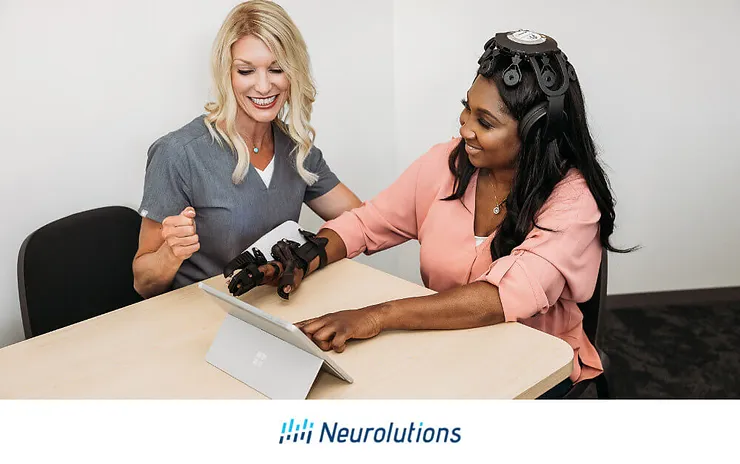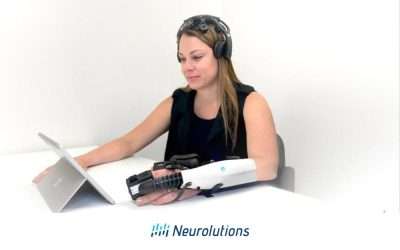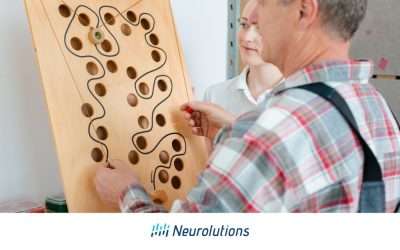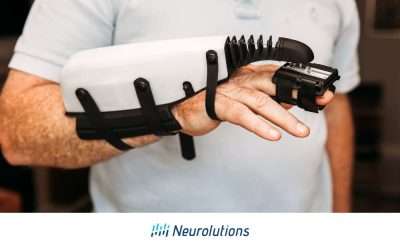As an occupational therapist who has worked over a decade of experience in neuro-rehabilitation services across all continuums of care, I often found myself frustrated when working with chronic stroke survivors who experience hemiparesis with little to no movement.
I would always use common, well-known techniques such as e-stim, vibration, quick stretch, and active-assisted range of motion. Although these techniques are effective, the results tend to be short-lasting with little or no carryover outside of the therapy session. Not only can this be incredibly frustrating for the occupational therapist, but also very disheartening for the client.
Is the IpsiHand Effective?
When I began working with the IpsiHand project in the first proof of concept research study, I was fascinated by the new technology, but even more than that, I was excited by the results I was seeing in our first group of users. Survivors who had not been able to use their hands since their stroke were now able to use their hand for functional activity. Survivors were reporting the ability to now complete everyday tasks which they were previously unable to do such as using their weak arm for tasks such as eating and drinking, scratching their face, or doing things that they love such as fishing.
Years later, after FDA approval and continued studies, the IpsiHand which is powered by brain-computer interface technology is now providing a new option for store survivors. Specifically, the IpsiHand is for therapists or individuals who have not had good results with traditional therapy.
As a clinician, what I find most exciting and arguably most important about the use of the IpsiHand is how long the results last. Individuals who have used the IpsiHand for 3 months demonstrate the gains 6 months later as they did right after use.
As a therapist, these durable gains are invaluable to me. I always want to give my patient the “best bang for their buck” so to speak. Most technologies I have worked with in the past are only effective when the patient is wearing it or using it. I love the fact that my patient does not have to wear the IpsiHand after treatment and that they are free to house their hand functionally after use which is always a goal for therapy.
|
Discover expert insights on stroke recovery! Join Emily J. Morgan as she unveils essential occupational therapy techniques for enhancing upper extremity function in stroke survivors. Dive into her detailed article to learn innovative strategies that can empower patients towards a more independent life. Click here to read more! |
How Does the IpsiHand Work?
The IpsiHand works through the use of brain-computer interface technology. While wearing the EEG headset, the client uses their own power of thought. We can all imagine ourselves moving even when we do not have the physical ability to do so, such as with the loss of movement following a stroke.
When using the IpsiHand brain-computer interface system, someone who has experienced a loss of movement due to a stroke can now use the power of thought to move the handpiece on their hand.
What is Brain-Computer Interface?
Brain-computer interfaces, also referred to as BCIs, are devices that collect and analyze brain signals, then translate them into commands. BCIs do not rely on typical neuromuscular pathways for output. The primary goal of brain-computer interfaces is to help individuals with neuromuscular conditions, such as stroke, spinal cord injury, or cerebral palsy, regain functional abilities. You can learn more about BCIs in our blog.
How Does the IpsiHand Feel?
When wearing the IpsiHand, it is very intrinsically motivating as the client is using their power of thought to move the handpiece.
Overall, it is lightweight when wearing and easy to get on and off one-handed or with help. It is best to have a comfortable place in the clinic or home which allows support of the handpiece and tablet on a table in an easily accessible environment to allow for appropriate use of components of the device. The EEG headset weighs less than a pound and the handpiece weighs 1.15 pounds allowing ease of use when using due to its lightweight nature.
Final Words on the IpsiHand
In conclusion, the IpsiHand is a new technology designed to be inclusive for individuals with little to no movement of the upper extremity following a stroke. For this population, many of the available items on the market require a minimum of movement to participate in their product of protocol. This new technology holds a promise for continued progress mod recovery following stroke for those individuals who previously had little to no treatment options for the arm. Finally, occupational therapists are uniquely positioned as there is much more to learn about BCI, but the only way to get there is to continue to try this new technology in clinics and learn from those that use it in order to apply this in real-time and build on its use and application.
As a therapist, I know how stressful it can be to learn a new product to be used in a clinic, much less a new technology like the IpsiHand. What was helpful for me when I was learning how to use the Neurolutions system, was to remember that it uses principles that we already know such as mental imagery, high repetition, and action observation. This is my call to action to say “YOU GOT THIS”. Let us produce the best therapy we can!




